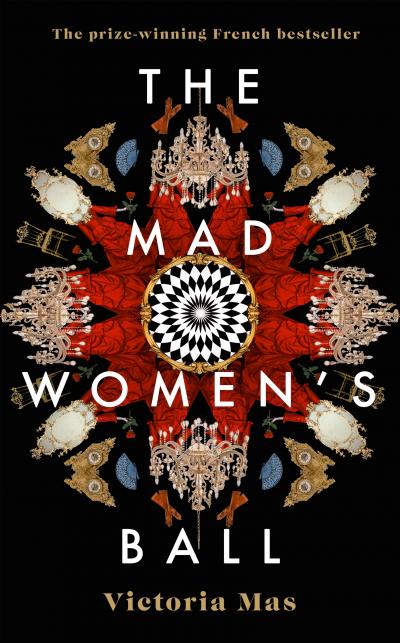Victoria Mas: The Mad Women's Ball review - compelling plot meets disquieting history | reviews, news & interviews
Victoria Mas: The Mad Women's Ball review - compelling plot meets disquieting history
Victoria Mas: The Mad Women's Ball review - compelling plot meets disquieting history
Reimagining the lives of the women incarcerated in the Hôpital Pitié-Salpêtrière

To this day, if you take a stroll down Paris’ Boulevard de l’Hôpital, you’ll come across an imposing building: the Hôpital Pitié-Salpêtrière. It’s one of Europe’s foremost hospitals. It’s the place where 20th-century icons Josephine Baker and Michel Foucault departed this world, and its halls buzz with budding young medical students from La Sorbonne.
Set in 1885, and translated from the French by Frank Wynne, Victoria Mas’ novel is a compelling and immensely readable reimagining of this complex space as seen through the eyes of the women who inhabit it. Of course, there is always a second, and just as important, gaze at play: the outside world, in which we, as readers, play some part. The story bubbles with anticipation as Mas builds towards the climactic event of the year, the Salpêtrière’s annual costume ball. It’s the night when Parisian society is invited in to ogle at the spectacle of captive women in ballgowns, and when captive women in ballgowns are afforded some small stimulation in the company of respectable society (and yes, this really did used to happen at the Salpêtrière).
 Protagonist Eugénie is a bright young thing, intelligent and inquisitive. She is comfortably middle-class, and despite her unfavourable tendency to speak her mind, muddles through her prescribed existence out in Parisian society with relative ease. The Mad Women’s Ball stresses one message above all else, though. Neither Eugénie’s class nor her intelligence can protect her from her one fatal flaw. She is a woman. And whether she realises it or not, she exists on a knife edge of obedience and omission where a single wrong step could mean the end of her life as she knows it. Like all women, she is never more than a few words or gestures away from disgrace. And so when she confides in her grandmother that she is able to see spirits, the hasty path to the Salpêtrière appears to be set in stone.
Protagonist Eugénie is a bright young thing, intelligent and inquisitive. She is comfortably middle-class, and despite her unfavourable tendency to speak her mind, muddles through her prescribed existence out in Parisian society with relative ease. The Mad Women’s Ball stresses one message above all else, though. Neither Eugénie’s class nor her intelligence can protect her from her one fatal flaw. She is a woman. And whether she realises it or not, she exists on a knife edge of obedience and omission where a single wrong step could mean the end of her life as she knows it. Like all women, she is never more than a few words or gestures away from disgrace. And so when she confides in her grandmother that she is able to see spirits, the hasty path to the Salpêtrière appears to be set in stone.
There’s something of The Handmaid’s Tale in the dystopian systems of oppression that have led to the mass incarceration of perfectly healthy women. After all, The Mad Women’s Ball confirms what anybody with a cursory knowledge of the institution already knew: that the majority of the women within the Salpêtrière’s walls were not mentally ill; instead, victims of abuse, rape and exploitation. We meet women disowned to salvage a family’s reputation, or pushed to desperate acts of vengeance against their tormentors, for which they are punished.
Every encounter between the women in the novel’s present (the book is written in the present tense, so we are always in the moment) feels like an intervention into a bizarre continuum of incarcerated life. Their days are marked by routine and are only differentiated by the approaching proximity of the ball. But as new patients like Eugénie arrive, filled with fresh rage and confusion, we are struck by the contrast. Like a modern-day prison drama, Mas’ characters constantly pique our curiosity as we yearn to learn more about the histories that led them there.
It would have been easy to choose an objectively "well" woman as a focus for the book. But had Mas done so, our novel would be all injustice and frustration. Instead, Eugénie is a challenge: her ability to commune with the dead is troubling even to contemporary sensibilities. She gets us thinking. Her abilities are both an important plot driver and a point of intrigue for the reader. And if we feel sympathy for the woman who sees ghosts, then we are definitely open to reevaluating the "madness" of her fellow Salpêtrière women.
Reading The Mad Women’s Ball, I found it terrifying to imagine myself in a world where I was constantly at risk of incarceration without having broken any law. But Mas made me challenge my contemporary eye on the matter, because there’s a flip-side, delicately dropped into the dialogue between the women of the Salpêtrière so as to suddenly throw a curve ball at our understanding. For many of the "patients", the Salpêtrière is a haven precisely because it is cut off from the outside world. It is a release from the pressures of an inherently misogynistic society, a shelter from the men whose violent or exploitative deeds have driven these women to the extremities of "acceptable" conduct, and a space for women to live in relative peace. As we discover, the oldest of the residents, ex-prostitute and mother hen Thérèse, will go to any lengths to ensure that she never has to leave again…
Mas’ characters are never truly outside of the system. The voyeuristic, invasive and performative examinations of the much-lauded male doctors (the type we can see in André Brouillet’s 1887 painting “A Clinical Lesson at the Salpêtrière”) are of course just another incarnation of male coercion, only this time in the name of progress. But it’s the tensions which Mas creates that really make the novel so enjoyable. Are they safer out or in? What really separates the female nurses from the patients? Does it matter if the public attend the ball to ogle when the benefits are so tangible to the women whose days are otherwise marked out only by medications and examinations? Raising as many questions as it answers, The Mad Women’s Ball provides a short but stimulating read, and redresses a questionable period in medical "progress".
- The Mad Women's Ball by Victoria Mas, translated by Frank Wynne (Doubleday, £14.99)
- Read more book reviews on theartsdesk
rating
Explore topics
Share this article
The future of Arts Journalism
You can stop theartsdesk.com closing!
We urgently need financing to survive. Our fundraising drive has thus far raised £49,000 but we need to reach £100,000 or we will be forced to close. Please contribute here: https://gofund.me/c3f6033d
And if you can forward this information to anyone who might assist, we’d be grateful.

Subscribe to theartsdesk.com
Thank you for continuing to read our work on theartsdesk.com. For unlimited access to every article in its entirety, including our archive of more than 15,000 pieces, we're asking for £5 per month or £40 per year. We feel it's a very good deal, and hope you do too.
To take a subscription now simply click here.
And if you're looking for that extra gift for a friend or family member, why not treat them to a theartsdesk.com gift subscription?
more Books
 'We are bowled over!' Thank you for your messages of love and support
Much-appreciated words of commendation from readers and the cultural community
'We are bowled over!' Thank you for your messages of love and support
Much-appreciated words of commendation from readers and the cultural community
 Robin Holloway: Music's Odyssey review - lessons in composition
Broad and idiosyncratic survey of classical music is insightful but slightly indigestible
Robin Holloway: Music's Odyssey review - lessons in composition
Broad and idiosyncratic survey of classical music is insightful but slightly indigestible
 Thomas Pynchon - Shadow Ticket review - pulp diction
Thomas Pynchon's latest (and possibly last) book is fun - for a while
Thomas Pynchon - Shadow Ticket review - pulp diction
Thomas Pynchon's latest (and possibly last) book is fun - for a while
 Justin Lewis: Into the Groove review - fun and fact-filled trip through Eighties pop
Month by month journey through a decade gives insights into ordinary people’s lives
Justin Lewis: Into the Groove review - fun and fact-filled trip through Eighties pop
Month by month journey through a decade gives insights into ordinary people’s lives
 Joanna Pocock: Greyhound review - on the road again
A writer retraces her steps to furrow a deeper path through modern America
Joanna Pocock: Greyhound review - on the road again
A writer retraces her steps to furrow a deeper path through modern America
 Mark Hussey: Mrs Dalloway - Biography of a Novel review - echoes across crises
On the centenary of the work's publication an insightful book shows its prescience
Mark Hussey: Mrs Dalloway - Biography of a Novel review - echoes across crises
On the centenary of the work's publication an insightful book shows its prescience
 Frances Wilson: Electric Spark - The Enigma of Muriel Spark review - the matter of fact
Frances Wilson employs her full artistic power to keep pace with Spark’s fantastic and fugitive life
Frances Wilson: Electric Spark - The Enigma of Muriel Spark review - the matter of fact
Frances Wilson employs her full artistic power to keep pace with Spark’s fantastic and fugitive life
 Elizabeth Alker: Everything We Do is Music review - Prokofiev goes pop
A compelling journey into a surprising musical kinship
Elizabeth Alker: Everything We Do is Music review - Prokofiev goes pop
A compelling journey into a surprising musical kinship
 Natalia Ginzburg: The City and the House review - a dying art
Dick Davis renders this analogue love-letter in polyphonic English
Natalia Ginzburg: The City and the House review - a dying art
Dick Davis renders this analogue love-letter in polyphonic English
 Tom Raworth: Cancer review - truthfulness
A 'lost' book reconfirms Raworth’s legacy as one of the great lyric poets
Tom Raworth: Cancer review - truthfulness
A 'lost' book reconfirms Raworth’s legacy as one of the great lyric poets
 Ian Leslie: John and Paul - A Love Story in Songs review - help!
Ian Leslie loses himself in amateur psychology, and fatally misreads The Beatles
Ian Leslie: John and Paul - A Love Story in Songs review - help!
Ian Leslie loses himself in amateur psychology, and fatally misreads The Beatles
 Samuel Arbesman: The Magic of Code review - the spark ages
A wide-eyed take on our digital world can’t quite dispel the dangers
Samuel Arbesman: The Magic of Code review - the spark ages
A wide-eyed take on our digital world can’t quite dispel the dangers

Add comment